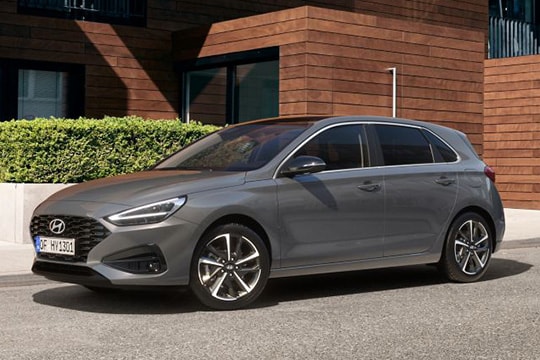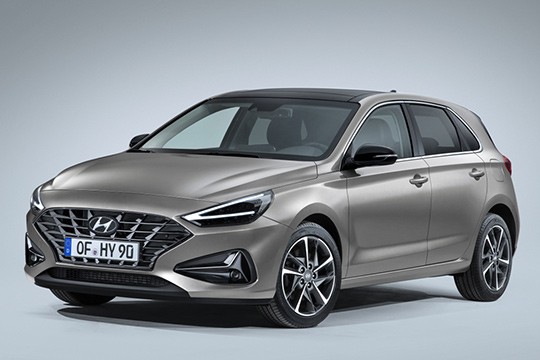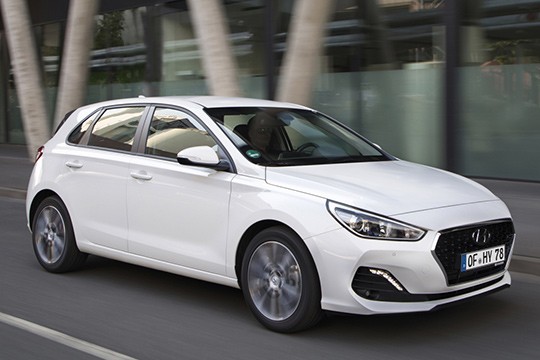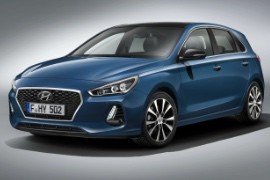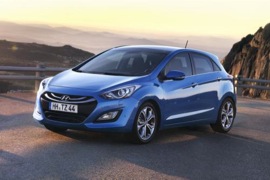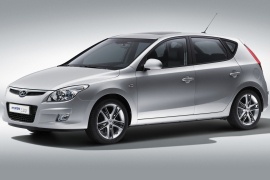HYUNDAI i30 Models/Series Timeline, Specifications & Photos
First production year: 2007
Engines: Mild hybrid, Gasoline, Diesel
Body style: Hatchback
Hyundai refreshed the third generation of its compact-sized i30 at the beginning of 2024, continuing its assault in the European mass-market hatchback segment where it had to face the well-known VW Golf and the Renault Megane.
While Hyundai replaced the first two generations of the i30 just five years after their launch, it surely slowed down the pace with the third iteration of this nameplate. This was introduced in 2016 and was refreshed in 2020. But then, the world pandemic started. To add insult to injury, the microchip crisis affected the car industry as well. As a result, the Korean automaker didn’t come up with a new generation of the i30 in 2021, as expected. Moreover, it didn’t do that even in 2024, but with a second facelift, which was an unusual decision. The model’s sales were far from the six figures prior to 2020, and Hyundai tried to keep the car on the green side of the charts for as long as possible. Meanwhile, its engineering department had its hands full in developing new electric and electrified vehicles, which enjoyed great success. So, instead of creating a fourth generation of the i30, it came with a refresh that helped the car stay on the market for a little bit more.
There were some mild changes on the car’s front compared to the 2020 model year. It featured a redesigned front grille that was black instead of gray. The lower bumper still had the triangular side scoops, albeit with a new design that integrated piano-black trims and round fog lamps. Between them, the automaker placed a black A-shaped air intake that helped to improve engine cooling and other components of the i30. One of the most significant upgrades to the vehicle was the standard LED headlights, which were offered as an option for its non-facelifted sibling.
Hyundai made almost no changes to the car’s profile, albeit there were a few new options for the 16-inch alloy wheels. In addition, the car was available in 12 different colors, seven of which were new. A significant upgrade was noticed at the car’s back, where the automaker installed a pair of new LED taillights. Besides the standard version, the automaker also offered an N-Line trim level, which added twin exhausts at the back and distinctive gray aerodynamic elements on the side sills, bumpers, and a unique set of 17 or 18-inch N-Line alloy wheel designs.
Inside, there were also barely visible changes to the vehicle. However, customers could still get the 2024 i30 with a choice of four types of upholstery, ranging from regular cloth materials to full leather or a mix between textile suede and leather. Inside the instrument cluster, Hyundai installed two large dials for the speedometer and tachometer that flanked a 4.2-inch color display. As an option, customers could get a fully digital instrument panel. They also had three USB type-C charging ports at the front and OTA updates for the map. Atop the center stack, the i30 was available with a 10.25-inch touchscreen for the infotainment unit. Those looking for a sportier interior could get the N-Line trim, which added high-bolstered front seats instead of the regular bucket-type ones provided by the rest of the i30 range.
Under the hood, the automaker introduced a new engine, which was available with a 48-volt architecture for the mild-hybrid system drivetrain.
After a successful start in 2016, the compact hatchback from Hyundai, the i30, has received a facelift in February 2020 with a new design, signed by Peter Schreyer.
The former designer from Audi-Volkswagen, Peter Schreyer, was in charge of the design for the whole Kia-Hyundai range after its arrival in the Korean group in 2006. His ideas completely changed the way these two brands look and, as a consequence, the sales rocketed. And he tried its hand, again, with the facelift for the i30.
On the front of the 2020 i30, there was a new bumper with a more aggressive design. A larger grille with a new design for the mesh was introduced. A new pair of headlights with built-in daytime LED running lights. Apart from the N-Line that featured black mesh on the front, the rest of the range featured classic, chromed elements. In the back, the new taillights received new LED graphics.
Inside, the 2020 i30 received an improved infotainment system with a 10.25” screen, which was a carry-over from the Kona and Ioniq. For the instrument cluster, a 7” TFT display replaced the analog dials.
While the aesthetic was little changed, the engine compartment received new units. The 2020 model received a new mil-hybrid version. For the transmission, Hyundai offered a 6-speed manual or a 7-speed dual-clutch system.
Needless to say, Hyundai’s been offering pretty good options for the past few years, keeping the prices low. The i30 was no exception, it was a budget car with a well-balanced package included.
Compared to the older generations of the i30, the 2018 model came with redesigned lines, somehow positioning the compact into the elegant category.
Even if the i30 was a small compact, there was more than enough leg room and head room for the passengers in the rear, with the exception of the middle seat that was suitable for a child only.
The trunk space was no disappointment with its 395L – a good matchf for a family with 1 child would have no problems to go on a holiday with the i30. The downside would be the access to the load area, a bit uneasy due to the way it was positioned. The trunk was also equipped with a 12V socket.
For a budget car, the i30 was pretty well equipped, the top version including lane assist, autonomous braking, a heated steering-wheel, a rear-view camera and the best part, an 7-speed automatic transmission.
The front seats offered a good driving position and a healthier one, having a lumbar support.
What seemed surprising, the i30 had a silent engine and the noises outside could hardly be heard inside the vehicle.
It is interesting how Hyundai increased the quality of their materials and noticeably paid more and more attention to the details over the years, still managing to offer their vehicles at a relatively low price.
If you can bear with the small downsides and take into consideration the 5-year ulimited mileage warranty, the i30 sounds like a perfect choice.
Hyundai chose the 2016 Paris Motor Show to unveil the third generation of its compact-sized contender, the i30, after only five years on the market for its predecessor.
Changing generations that soon was a strategy used by the Japanese carmakers in the late '80s-early '90s proved effective. Moreover, the Korean carmaker seemed like it learned that lesson and successfully applied it to its range. Thus, in just nine years, Hyundai launched three generations of its compact vehicle, and the improvements brought were obvious.
With this third generation, the i30 looked like it was already a mature vehicle with a clear design language. It already showed the angular styling of the headlights, with swept-back sides but with less rounded lines than its predecessor. The grille, wider at the top and narrower at the bottom, covered the center of the front fascia and was flanked by two side scoops that hosted the DRLs. Its profile kept the third window behind the rear doors, but it offered an increased glass area. Last but not least, the tailgate received, depending on the options, a roof spoiler.
Inside, the evolution was impressive. Even though it somehow resembled other German cars, it showed a decent level of craftsmanship and above-average materials. As an option, the carmaker added the infotainment system atop the center stack, in a way already seen on other vehicles, such as the Mercedes-Benz A-Class. The i30 featured a split-folding bench at the back that expanded the trunk from 391 liters (13.8 cu-ft) to 1,301 liters (45.9 cu-ft).
Under the hood, Hyundai introduced a new generation of turbocharged, direct fuel-injected engines that developed up to 140 PS (138 hp) paired either with a six-speed manual or a seven-speed automatic transmission.
Unveiled at the 2011 Frankfurt International Motor Show, the Hyundai i30 was a small family hatchback that offered good value for money.
As expected from a small city car, the suspension was designed to be comfortable, however, the steering felt fake and wasn’t very precise.
The i30 offered a wide range of engines to choose from, 4 units with a total of six power options. All powerplants had low CO2 emissions.
One of the strongest points was the i30’s cabin. It was fitted with high quality materials and the buttons were simple and well-laid-out.
Standard features included LED running lights, air-conditioning, Bluetooth connectivity and even a multi-function steering wheels, even in the cheapest versions available.
It was easy to get comfortable in the front seats, and even the rear occupants would have had no reasons to complain as the roomy cabin offered great legroom and headroom.
The trunk size was one of the biggest in the class and offered plenty of storage. The low lid made it extremely practical for loading heavier items.
Safety was one of the top priorities, with the i30 featuring ESP, Vehicle Stability Management, ABS, a Brake Assist System, Hill Assist Control and Emergency Stop Signal.
A strong performer on the market, the i30 offered a classy cabin, plenty of space and lots of technology for a competitive price.
The first generation of the i30 came at the right time and the right moment. It was one of the best compact-segment vehicles introduced in 2007.
Just before the world financial crisis burst the automotive industry into tears, the Hyundai-Kia carmaker introduced the i30-cee'd duo on the market. They both shared the same platform, and compact-segment customers appreciated the new design.
Even though it resembled some elements from the Mazda 3 hatchback (the rear side) or the Ford Focus facelift headlights, the exterior was adequate for its customers. Its narrow grille was smaller than the one fitted on its sibling, the Kia cee'd. The car was designed in Hyundai's design center from Russelsheim, Germany, and it showed its real intention to conquer the European market. In the rear, the tall taillights were extended from the c-pillars to the rear bumper.
Inside, the i30 showed good taste in choosing colors for the dashboard and door panels despite the use of budget materials. Unlike the cee'd, which showed different light colors for the dashboard, the i30 stuck to the light-blue bulbs and induced a relaxed mood for the driver and occupants. Like any other hatchback from those times, the car featured a split-folding rear bench, where there was room for three passengers but with limited shoulder room.
Under the hood, Hyundai installed a choice of diesel and gasoline engines ranged between 109 hp and 143 hp. While most versions were paired to a 5-speed manual, some versions were available with a 4-speed automatic transmission. Its independent suspension in all corners was a plus and placed the i30 in the comfort zone over the Renault Megane or the Opel/Vauxhall Astra.
